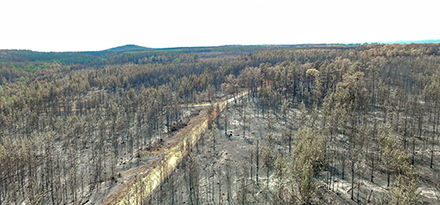
Mount Topper State Forest
Forestry Corporation of NSW has recently started salvage-harvesting of its burnt pine plantations at Mount Topper State Forest. The forest is a short distance north of the Tingha township and one of the many properties affected by the devastating fires earlier this year. Source: Timberbiz
While the entire 400ha Mount Topper State Forest was burnt, damage to mature pine plantation was limited to around 300ha of the remaining mature pine plantation thanks to recent harvesting operations.
Forestry Corporation’s Northern Softwoods Regional Manager Jason Molkentin said that while the State’s plantation has suffered extensive damage, there is a bigger picture.
“At Forestry Corporation, we are conscious that many properties were impacted far more than the losses we’ve sustained,” Mr Molkentin said.
“I’m also proud of the contribution of our staff, who worked with landholders and other agencies to protect life and property while the fire raged.”
Locals and visitors should be aware that as harvesting is underway at Mount Topper State Forest, log trucks will be operating on local roads and access to the forest will be restricted.
It is important to heed signs and be aware of the increased risk of falling trees in burnt forest areas.
There is potential to recover a significant part of the value of burnt trees, provided the salvage operation is undertaken in a timely manner.
“Dead trees can readily deteriorate due to insect attack and decay, making logs potentially unsaleable,” Mr Molkentin said.
“There is a window of opportunity over the next few months to complete our salvage operations, so we need to move quickly.
“We’re working closely with our customers and contractors in the region to salvage as much burnt wood as possible.”
While Forestry Corporation’s immediate focus is on salvaging burnt timber, the organisation will soon turn its attention to remediating the plantation and ensuring its long-term viability.
Last year, Forestry Corporation’s Softwood Plantations Division harvested close to two million cubic metres of sawlogs and 1.4 million tonnes of pulp logs, which is a sizeable proportion of the State’s timber needs.





